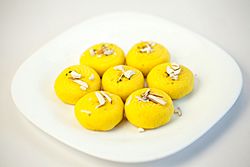Peda facts for kids
 |
|
| Alternative names | Pedha, Pera |
|---|---|
| Course | Dessert, Prasāda, Sweet |
| Place of origin | Indian subcontinent (Mathura, Uttar Pradesh, India) |
| Region or state | Indian subcontinent, Mauritius, Fiji, southern and eastern Africa, the Caribbean, the Malay Peninsula |
| Main ingredients | Khoya, sugar |
Peda, also called Pera, is a yummy sweet treat from the Indian subcontinent. It first came from a city called Mathura in Uttar Pradesh, India.
Peda is usually thick and a bit soft. Its main ingredients are khoa (which is dried milk solids) and sugar. It often has tasty flavors like cardamom seeds, pistachio nuts, and saffron. Peda can be creamy white or a nice caramel color. The word peda can also mean a round ball of any doughy stuff, like flour or khoa. Other ways to spell it are pedha or penda.
Contents
What is Peda?
Peda is a popular Indian sweet. It is made from khoa, which is milk that has been cooked down until it becomes solid. This gives Peda its special creamy texture. After making the khoa, sugar is added. Then, different spices and nuts are mixed in for flavor.
Common flavors include cardamom, which is a spice with a strong, sweet smell. Pistachio nuts add a nice crunch and green color. Sometimes, saffron is used, which gives Peda a beautiful yellow-orange color and a unique taste. Peda is often shaped into small, round, or flattened balls.
Where Did Peda Come From?
Peda sweets first started in the city of Mathura in Uttar Pradesh, India. The Mathura Peda is a very famous type from this city. From Uttar Pradesh, Peda became popular in many other parts of the Indian subcontinent.
In the 1850s, a person named Thakur Ram Ratan Singh moved from Lucknow to Dharwad in Karnataka. He brought the idea of Peda with him. This led to a special kind of Peda called Dharwad pedha, which is now very well-known.
Different Kinds of Peda
There are many different kinds of Peda, each with its own special touch.
- The Mathura Peda is the original and classic type.
- The Dharwad pedha from Karnataka is famous for its unique taste and texture.
- Kandi Peda comes from Satara in Maharashtra.
- Dood Peda is another popular type. It is known for its milky flavor and is often made by milk companies.
These different types show how Peda has changed and grown in popularity across India.
Peda in Traditions
Just like other Indian sweets such as laddoos, Pedas are sometimes used in religious ceremonies. They are offered as prasadam. Prasadam is a sacred offering of food to a god, which is then shared among people as a blessing. This shows how important Peda is in both daily life and special traditions.
Images for kids
See also
 In Spanish: Peda para niños
In Spanish: Peda para niños



